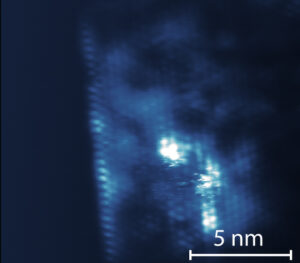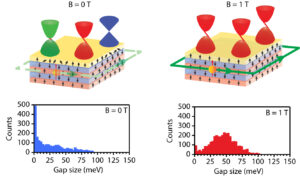Overcoming magnetic disorder is key to exploiting the unique properties of QAH insulators.
The Monash-led team demonstrated that the breakdown in topological protection is caused by magnetic disorder, explaining previous observations that topological protection could be restored by application of stabilising magnetic fields.
“The study paves a clear research pathway towards use of MTIs in low-energy topological electronics,” says lead author FLEET PhD candidate Qile Li (Monash University).
The challenge
When combined, magnetism and topology can yield the quantum anomalous Hall effect (QAHE) allowing for electrical currents to flow without resistance along one-dimensional edges across macroscopic distances.
Yet, the current flow along these topologically-protected, one-dimensional edges has proven to be far from robust. With the QAHE breaking down in magnetically-doped topological insulators at temperatures higher than 1 Kelvin, well below the temperatures predicted by theory.
A new class of materials, known as intrinsic magnetic topological insulators (MTIs), for example MnBi2Te4, possess both non-trivial topology and intrinsic magnetism and are predicted to offer more robust QAHE at higher temperatures than magnetically-doped topological insulators.

Conductance map taken with a scanning tunnelling microscope showing the gapless edge state and its coupling to metallic bulk states.
In MnBi2Te4 it has been shown that the QAHE can survive up to 1.4 K, and interestingly, this can rise to 6.5 K with the application of stabilising magnetic fields, providing hints at the mechanisms which are driving the breakdown of topological protection.
However, 6.5 K is still well below the 25K that is predicted by theory. To advance these materials towards potential applications it is necessary to raise that temperature to the hard-line limit set by the magnetic bandgap energy and magnetic transition temperature. And this requires a better understanding of the precise mechanisms involved in the breakdown of topological protection at the material surface.
Studying interplay between surface disorder, bandgap fluctuation, and edge state
To fully understand what was happening the Monash-led team used direct, atomically-precise measurement of the interplay between surface disorder, local fluctuations in the bandgap energy, and chiral edge state.
The team used low-temperature scanning tunnelling microscopy and spectroscopy (STM/STS) to study five-layer, ultra-thin film MnBi2Te4.
How the bandgap fluctuates was studied at the location of crystal defects, as well as at the edge and interior of the five-layer film – to understand what might cause the breakdown of QAHE.
The team also applied low magnetic fields, observing the bandgap and QAHE could be restored.
The applied magnetic fields are well below the spin-flop transition for MnBi2Te4.
Results in five-layer MnBi2Te4 reveal a magnetic villain

Corresponding author FLEET Associate Investigator Dr Mark Edmonds (Monash School of Physics and Astronomy)
The research team found long-range fluctuations in bandgap energy in the interior of the film, ranging between 0 (gapless) and 70 meV, and not correlated to individual surface defects.
Directly observing the breakdown of topological protection shows that the gapless edge state, the hallmark signature of a QAH insulator, hybridises with extended gapless regions in the bulk.
These results demonstrate that:
- The gapless edge state in MnBi2Te4 is directly coupled to extended percolating bulk metallic regions arising from band gap fluctuations caused by magnetic surface disorder.
- Band gap fluctuations can be greatly reduced by applying a magnetic field, increasing the average exchange gap to 44 meV, close to predicted values.
“These results provide insight on the mechanism of topological breakdown and how it can be restored in a magnetic field,” says Corresponding author FLEET Associate Investigator Dr Mark Edmonds (also at Monash).
The study

Demonstrating how the exchange gap spatial fluctuation caused by surface magnetic disorder can be reduced significantly by applying a perpendicular magnetic field
Imaging the breakdown and restoration of topological protection in magnetic topological insulator MnBi2Te4 was published in Advanced Materials on 13 June 2024 (DOI 10.1002/adma.202312004)
As well as funding from the Australian Research Council’s (ARC) Centre of Excellence and Future Fellowship programs, support was received from the Australian Institute of Nuclear Science & Engineering (AINSE) postgraduate award. ARPES measurements were performed on the beamline at the US Department of Energy’s Advanced Light Source (ALS) at Lawrence Berkeley, with travel funding from the International Synchrotron Access Program (ISAP) managed by ANSTO’s Australian Synchrotron. Work was performed in part at the Melbourne Centre for Nanofabrication (MCN), the Victorian Node of the Australian National Fabrication Facility (ANFF).
More information
- Contact Dr Mark Edmonds (Monash University) Mark.Edmonds@monash.edu



